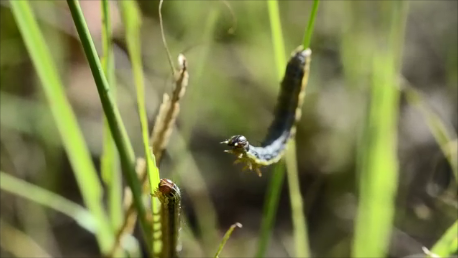Farm & Ranch
[AgriLife Today] Fall armyworms are on the march

By: Adam Russell
- Writer: Adam Russell, 903-834-6191, [email protected]
- Contact: Vanessa Corriher-Olson, 903-834-6191, [email protected]
OVERTON – Fall armyworms are on the march in parts of Texas.
Texas A&M AgriLife Extension Service agents in a few of the agency’s districts have reported increased armyworm activity in hayfields and pastures over the past few weeks. Dr. Vanessa Corriher-Olson, AgriLife Extension forage specialist in Overton, said producers should expect an increase in armyworm numbers following recent rains and cooler temperatures in areas of the state.
“I was getting calls about them before the rain,” she said. “They like cooler temperatures and wet conditions in the spring and fall, so we could see a swell in their numbers.”
Armyworm moths can lay up to 2,000 eggs that hatch in two to three days, according to a 2015 report by AgriLife Extension entomologist Dr. Allen Knutson. There are four to five generations per year.
Corriher-Olson said armyworm caterpillars are picky eaters that prefer high–quality, fertilized forage typically found on fields maintained for hay production. They are a common pest of Bermudagrass, sorghum, corn, wheat, rye grass and many other crops in north and central Texas.
Producers should scout each morning for armyworms, she said. Armyworms are night feeders that try to avoid daytime temperatures.
Armyworms are green, brown or black in color and can be identified by the white inverted Y on their head. They can grow up to 1 inch in length when mature.
https://www.youtube.com/watch?v=hZlhX9mSkRU
The pest got its name because they appear to march across hay fields, consuming the grass in their path.
The threshold for insecticide spray treating a pasture is three or more armyworms per square foot, Corriher-Olson said. Armyworms in those numbers should be treated immediately. Armyworms in the last two or three days of their larvae stage consume 85 percent of their diet.
Corriher-Olson recommends insecticides labeled for armyworm control in pastures and hayfields. She said applicators should always follow all label instructions on pesticide use and restrictions.
“You don’t need to wait a day if their numbers are at threshold,” she said. “They are going to do a lot of damage quickly. If you find them in the morning, spray that day.”
More information about armyworms can be found in Knutson’s report The Fall Armyworm – Pest of Pastures and Hay at: http://foragefax.tamu.edu/files/2015/08/Armyworm-Fact-Sheet-2015.pdf.
-30-
Find more stories, photos, videos and audio at http://today.agrilife.org
Farm & Ranch
Acorn Toxicity

By Barry Whitworth, DVM, MPH
With the prolonged drought, most pastures in Oklahoma end up in poor condition. With the lack of available forage, animals may go in search of alternative foods.
If oak trees are in the pastures, acorns may be a favorite meal for some livestock in the fall. This may result in oak poisoning.
Oak leaves, twigs, buds, and acorns may be toxic to some animals when consumed.
To read more, pick up a copy of the November edition of North Texas Farm & Ranch magazine, available digitally and in print. To subscribe by mail, call 940-872-5922.

Farm & Ranch
Silver Bluestems

By: Tony Dean
There are a handful of grasses on North Texas grazing lands ranchers need to know, not because they are highly desirable, but rather because they are not of much value. I call them “decom” plants, which is am acronym for “Don’t Ever Count On Me.” Silver bluestem is a “decom” grass.
Silver bluestem is a perennial which grows in all areas of Texas. It can survive in almost all soil types, and in full sun conditions or in semi shade. It grows up to three feet tall and is easily recognized with the presence of the white fuzzy seed head. Also, one of the identifying characteristics of Silver bluestem is a bend in the stems at each node, causing the plants to take on a rounded shape as they mature.
To read more, pick up a copy of the November edition of North Texas Farm & Ranch magazine, available digitally and in print. To subscribe by mail, call 940-872-5922.

Farm & Ranch
Meanwhile Back At The Ranch

By: Rayford Pullen
Fall is here which means winter is closing in on us and before we officially get into winter, we need to make sure our factories are either producing or will be producing in a few months.
We have been pregnancy testing our cows this fall and if they are not bred or nursing a calf, we are bidding them adios. With annual costs somewhere between $900.00 and $1,000.00 per cow, those cows not producing a live weaned calf are costing us quite a bit.
To read more, pick up a copy of the November edition of North Texas Farm & Ranch magazine, available digitally and in print. To subscribe by mail, call 940-872-5922.
-

 Country Lifestyles2 years ago
Country Lifestyles2 years agoScott & Stacey Schumacher: A Growth Mindset
-

 Country Lifestyles8 years ago
Country Lifestyles8 years agoStyle Your Profile – What your style cowboy hat says about you and new trends in 2017
-

 HOME8 years ago
HOME8 years agoGrazing North Texas – Wilman Lovegrass
-

 Equine1 year ago
Equine1 year agoThe Will to Win
-

 Country Lifestyles5 years ago
Country Lifestyles5 years agoAmber Crawford, Breakaway Roper
-

 Outdoor9 years ago
Outdoor9 years agoButtercup or Primrose?
-

 Country Lifestyles8 years ago
Country Lifestyles8 years agoJune 2016 Profile – The man behind the mic: Bob Tallman
-

 Country Lifestyles8 years ago
Country Lifestyles8 years agoDecember 2016 Profile, Rusty Riddle – The Riddle Way




